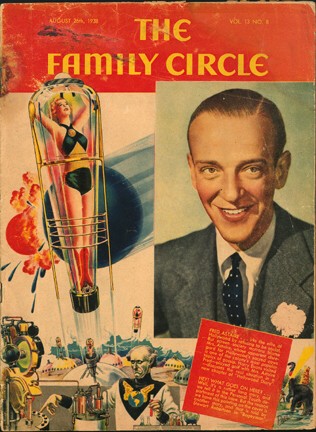
GALLERY OF FRANK R. PAUL's SCIENCE FICTION ARTWORK
artwork (c) Frank R. Paul estate
Cover Art by Frank R. Paul for Aug. 26, 1938, The Family Circle.
This issue featured a really nice article about Paul. The cover text reads: "HEY! WHAT GOES ON HERE? . . . Well, it's a rather long story, and we tell it in the Personal Touch department of this issue. But the reason we have this painting on the cover is another story, and that is told by Stewart Robertson in 'Bogeyman.'"
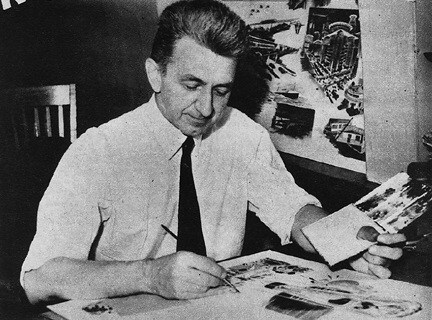
Foto of Paul painting the cover, from p. 18.
Text about the cover (from p. 3 of the magazine):
"THE PERSONAL TOUCH - In this issue is an article, 'Bogeyman,' about Frank R. Paul, an artist who makes cover illustrations for magazines which print thrill stories based on 'science.'
"When he is not picturing frightfulness, Frank Paul is fond of playing the violin and mandolin, and he has just composed a march called 'Uncle Sam's Garden,' which he hopes will be used in schools. His home is in Park Ridge, New Jersey, where he lives with his wife, three daughters, and a son. None of his family thinks of him as a bogeyman, and he doesn't scare his neighbors.
"Mr. Paul never has nightmares, by the way, but occasionally, when he finds himself being overcome by the sense of doom which pervades some manuscripts, he takes a gander out of the window of his office in downtown New York to make sure that the Brooklyn Bridge, so often demolished in type, is still there. So far, it always has been.
"THE COVER - When we read in 'Bogeyman' that Mr. Paul had never tried to draw the Supreme Intelligence, we thought it was about time he did, because there's no telling when he may get a call for it. We suggested, therefore, that he use it as his subject in the painting which we asked him to do especially for our cover. But one subject was too much of a cinch for Mr. Paul, so, in order to show more of his scope, he tossed three others in with the Supreme Intelligence.
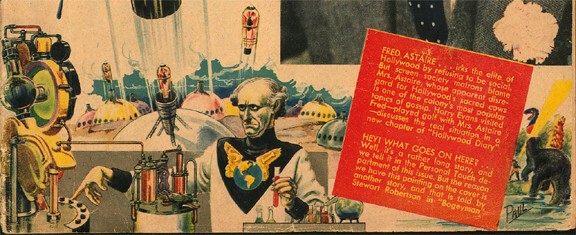
Detail of the cover.
"We think we would best leave the explanations of the four subjects to Mr. Paul:
"PREHISTORIC ANIMAL GETTING IT IN THE NECK: If you are contemplating a sojourn in time, or a camping trip to Venus or any other planet, be sure to have your sporting goods dealer include a ray-gun - one with three shifts, of course - in your pack. You will find it the most useful article you can take on such a jaunt.
"If you are confronted with natives on a strange planet and do not want to kill them, you press the paralyzer button on the ray-fun. If you feel the hot breath of a tyrannosaur or an ichthyosaur on your neck, merely press the M-button. (That stars the molecular vibrator, which will cut through the neck of any monster, modern or prehistoric. And those who know say that tyrannosaur steak, broiled over a Q-ray, is mighty tasty.) Or, if your path is blocked by a wall, mountain, or any other obstacle, just level your ray-gun and press the D-button. The obstacle will immediately disappear - disintegrate, in fact - and you can again proceed merrily on your way.
"COLLISION AT SPACE AND TIME STREET [The colliding balls behind the biggest girl]: We are now so far in the future that 2050 A.D. is way back in the past. But at about that time, space was suffering from the bends, and while bending it expended a tremendous amount of energy. This energy formed into a ball, solidified,* [*Footnote: Solid energy was what was known to the ancients (the people of 1938) as greased lightning on skids with ball bearings.] and decided to visit our solar system. Now, everybody knows that energy when solidified becomes blue in color. Consequently, this blue ball of energy, coming as it did out of the blue, was unnoticed until it was almost on top of our sun. The world, when it saw what was happening, breathlessly awaited its ghastly end.
"Then suddenly it dawned on a mastermind that by burning up all the secondhand rubber tires and shooting all the resulting gases into the stratosphere, he might create around our planet a protecting cushion which would absorb the shock of the collision. The collision occurred, as you can see on the cover, and the ball of energy was ignited by the sun and merged with it. The cushion of gas did save the earth from extinction, but one of the great blobs of energy which were flying around in space pierced the gas cushion and struck the earth a nasty wallop. However, all that energy hitting the earth at once did not result, as you might suppose, in catastrophe. Instead, the energy had an instantaneously beneficial effect. there was no more depression. Relifer administrators pursued those on their lists begging them to accept checks. Police had to keep employees away from factories, stores, and offices after working hours. And most amazing of all, the politicians all quit politics and went to work!
"GIRL GETTING FED THROUGH A TUBE: Long before the earth had become denuded of vegetation from various causes, scientists had discovered that sunlight contains everything necessary for sustaining life, provided you have the right kind of receiver and converter. And that discovery is what saved mankind when vegetation disappeared and all people had to go live underground.
"On the cover you see a young lady of the Fifth Millennium out in her tube getting her groceries. She has shot herself out of one of the glass domes which serve as observation towers and as exits into the outer world for the underground dwellers. The device in which the damsel is flying about is simplicity itself. The anti-gravity and atomic controls which she is operating with her hands can be mastered by anybody in one easy lesson. Sunlight penetrates the quartz tube and is immediately converted into food which is absorbed through the pores of the skin. A half-hour exposure invigorates the body and supplies energy for another week.
"The two plus signs under the young lady's initials in the circle below her neck indicate that she is about average in attractiveness. The real beauties get four or five. (We can hardly wait for the Fifth Millennium.)
'JUST CALL HIM JOE: Nothing is impossible to the Supreme Intelligence. He can cure all diseases; put surplus populations in suspended animation (but he doesn't do it in the same way that critics of the WPA say it does [as far as I can tell, this joke is about the government-sponsored, depression-era, job-generating Works Project Administration, which was accused of paying people to stand around, such as construction workers to goofing off, leaning on their shovels. -F.W.]); and provide food, heat, and shelter for billions out of air, earth, and water. Like all great dictators, however, the Supreme Intelligence wants to rule alone, and he punishes swiftly and severely anyone who opposes him.
"Once he was annoyed by a whole people who enjoyed a dance called the Big Apple. To teach them a lesson he changed the vibration period of the entire population and the next morning everyone was going around as if afflicted with locomotor ataxia.
"On the cover you see him testing out of his famous calculations. Naturally, he has invented his own method of calculus, having long since outgrown the kindergarten variety of arithmetic used by ancients like Edison, Steinmetz, and Einstein. The magnitude of his intellect may be judged by the fact that he can send his thought waves out on a light beam and make them deflect stars from their path and planets from their orbit. The letters S.I. on his chest stand for supreme Intelligence, of course, and were awarded to him when he was elected captain of the deep-thinking team at dear old Mastermind U.
"The problem to which he is seeking the solution in the cover picture is the familiar question 'How high is up?' He has figured it out that up stops being up where it starts being down, and that up starts being up where down stops being down. Therefore, all he has to do is measure the distance between where down starts being up and up starts being down. And that, chums, is just a warming-up exercise for the Supreme Intelligence.
"Hi-yah, Joe!"
[Text of the article on Paul:]
CRAAASSSH! New York City is being blown to smithereens by some strange invisible power! GLUP-UP-UPP!! The U. S. A. is slowly sinking beneath boiling oceans to become another lost Atlantis! SQUEEEEE !!! The world is being shrunk to the size of a pea - during which fiendish process the inhabitants go tumbling off to hang suspended in space, looking pretty silly until they starve to death! And out of the trackless void of the universe, where thunder, wind, and lightning brew their hellbroth, comes a maniacal chuckle which rises to the triumphant screech of a mastermind. But it's too late to duck now, for the Disaster and Destruction Boys are at it again !
All this may be news to you. If so, it's high time
that you know that the above catastrophes - and worse - are happening in every
issue of the pseudo-scientific, scare-head type of pulp magazine. Fantastic as
these yarns may be (and any one of them is likely to give Junior or Junior's old
man that butterflies-in-the-stomach sensation), the power of the printed word
runs a decided second to the flamboyant cover illustrations of our puerile
planet in the grip of hobgoblins, robots and general chaos. Which brings us to
Frank R. Paul.
As the artist who is responsible for delineating
the somewhat wacky mental concoctions of the authors of awfulness, Mr. Paul
might be expected to look a bit hagridden, if not actually hovering on the brink
of - well, you know what. But I am glad to report that he is neither. He has a
pleasant, composed manner, he is always smiling and he can hardly wait to wade
through a fresh crop of manuscripts to find out which one has the most lurid
pictorial possibilities. Mr. Paul can certainly fake it, but unless you have
read a few dozen of these yarns, you cannot begin to appreciate all that being
able to take it in his profession means. His iron-gray hair stands straight up,
but he denies that it is from fright.
"I get a tremendous kick out of my work,"
Mr. Paul told me when I visited him in his office in the old New York Tribune
Building at 154 Nassau Street. "When I run into a story so bizarre that it
seems to have too much of a muchness, I remind myself that our
great-great-grandfathers would have pooh-poohed prophecies of radio and
television and aviation. Many of our pulp magazine authors are military or naval
men, doctors, chemists, and other scientists, and when they contemplate the
amazing aspects of science which today we accept so matter-of-factly, they get
to wondering what life will be like in the future. And so they take a leap into
the dark - only they don't leave it dark very long because they drag in some
fancy rays and mysterious cosmic explosions.
"You'd be surprised at all the dirty work that can be charged off to rays," Mr. Paul continued. "Why, the alphabet has been exhausted to give them titles. Sometimes, when the ray angle gets overworked and the author doesn't want to make another ray the reason for, let's say, people suddenly swelling up and bursting like balloons, he pins the blame on something he calls the Supreme Intelligence. I've never tried to draw that, but I've done about everything else. Here, take a look." Mr. Paul pulled more than 100 cover illustrations from his desk. They were Mr. Paul's multicolored impressions of the fantastic goings-on which our deluded descendants may be in for during the next 500 years.
Some of Mr. Paul's serious work, on the other hand, has included a vast perspective weather map of the United States (published in Life) as seen from the air, with all storm centers charted, and school and college text book illustrations. He has also produced a picture showing how New York City would took if the bay were filled in, thus creating a new area on which to expand. And recently he submitted to officials of the New York World's Fair a drawing of a 350-foot, figure which would contain an educational exhibit. [See the Micromegas image. -F.W.]
"Do you ever suspect the sanity of the authors of these fanciful stories you Illustrate?" I asked Mr. Paul after we had looked at his magazine covers.
"Well, no more than that of the general run of writers," replied the artist, who is a charitable man. "One of the most popular authors of fantasticity, however, is a doctor at a Pennsylvania lunatic asylum [David H. Keller, M.D. - F.W.], and I imagine that helps.
"A favorite thrill-making device is to give gravity a good kicking around," Mr. Paul went on, "and what with gravity repelling suits, belts, and guns, it's no trick at all for the hero and his pals to step out of their space ship into mid-air and do a little repair job. Then up comes the villain equipped with a repeller which repels the other repeller, and our entire social fabric is on the verge of being ripped to shreds. But then our hero gets a brain wave. Clear blue eyes and 100% Americanism run for Sweeney in these stories, and all that counts is intellect - but boy, has the hero got intellect!
"And then there are some writers who play around with the fourth, fifth, or sixth dimension, and with the bent space theory, and with glands. They have a grand time, too, even though they may be rather uncertain about everything but high-powered horror,"
"But what about the power of love?" I asked, being just an old softy.
"Sex appeal is definitely out," Mr. Paul told me with pride. "The authors are intellectually honest in that respect, and no matter what sort of mess they work the plot into, they'd scorn having the super-fiend break down just because some blonde gave him the eye. When there is a girl in the story, she's generally used as some sort of stooge to squeal something trite like 'You can't do this to me!' when the super-fiend, encountering her atop Mount Everest, sicks a boa constrictor on her which is the size of a smokestack."
"But don't tell me that the poor girl is abandoned to her fate!" I protested, for this was before I had delved into chills-and-fever literature. "That would be hardly sporting. How is she saved?"
"Very simply," chuckled Mr. Paul. "For example, the hero, treading air with all his gravity gadgets, comes by and sees the girl's predicament. Off he flits to India in two seconds flat, finds a mongoose, which is the snake's natural enemy, feeds it a secret drug which blows it up to the size of a moose, and back they go to rescue Blondie. But our hero wastes no time on kissing or any such mush. In fact, he's likely to make it clear to her that she's definitely a nuisance for causing so much trouble."
'And where's the super-fiend all this time?" I asked.
"Oh, the hero's taken care of him, all right. 'You see, the hero has a pal who is a lock tender on one of the canals on Mars. Interplanetary communication is old stuff to our readers, remember, and they'd be disappointed if they didn't get it. Well, our hero's Martian friend opens the lock gates just enough to allow drops of water to fall upon the villain's head. It's the old Spanish Inquisition torture, of course, and naturally the villain goes nuts."
"But if drops of water could come all the way from Mars, they'd evaporate before - "
Mr. Paul grinned at my hairsplitting. "'If' is a word we never use," he said. "We don't need 'if' any more than we need a handsome hero. Of course, there may be a husky guy with a profile who is allowed to help out with the heavy work and stick out his neck in time of danger, but the real hero is more likely to be an ordinary-looking cuss like you or me.
"Let me give you the general plot of hundreds of stories," Mr. Paul continued. "The hero is a professor with a theory which everyone laughs at, or he's an obscure inventor who can't get a break for the machine which he has fabricated from his heart's blood, a little scrap iron, and a full portion of genius. Even for the reader it's hard at first not to get impatient with the fellow, who seems to have too many brains for his own good and who could do with a spot, of horse sense. The professor or the inventor naturally feels kind of sore at the rest of the world and he keeps mumbling about how 'there'll come a day.'
"And come it does. It's generally referred to as the Dawn of Doom, and that's when things really begin to happen ! In New York City all the elevators suddenly stand still and the buildings slide up and down. Long, slimy claws reach out of the Pacific and snatch up every citizen in San Francisco. Vast portions of the State of Kentucky disappear overnight as if nibbled by a gigantic sheep. Panic spreads! Havoc reigns! Civilization does its well known tottering act, and then the survivors, in their extremity, at last turn to the scoffed-at scientist, who by now is laughing up his sleeve at the woes of the world. So, after a couple of biting I-told-you-so's, he takes charge, rescues by sheer genius what is left-of Mother Earth, and his name becomes a household word."
I will say for Mr. Paul's fictioneers that they waste no time with such folderol as literary attitudinizing. Their method is to pour on the terror as quickly as possible, thereby inducing goose-pimples big enough to make you think of the craters of the moon. Their motto seems to be "Poe was a panty waist," and if they seem besotted with sadistic theories, it is only to make the ultimate victory of the hero more glorious than in less feverish fiction. Ah, what minds we have among us concealed beneath the drab exterior of authors! A little learning is a dangerous thing, sure enough, and I hope that the gent who conceived the destruction of America by having the insects inside Mexican jumping beans develop elephantiasis will bequeath his brain to some medical museum. Perhaps it will explain why heroes of such tales are seldom sensible to the wonder of love - or sensible at all.
"One of the things I enjoy about the yarns I illustrate," Mr. Paul resumed, "is the ingenious way in which they go from fact to frightfulness without a struggle. One story [Wonder Stories, Sept. 1929] was suggested by the fact that yeast will make a doughlike mixture rise, and with that as a basis, away went the plot on a rampage about huge walking cylinders which spewed a purple, poisonous, yeast-laden mixture that spread over the country, choking the soil and killing the people. What to do? A cinch, really. The hero went into a trance and evolved a herd of 100-foot-high digging machines which scooped up the poisonous mass faster than it could dribble from the cylinder. I visualized the digging machines as resembling enormous crimson chickens scratching for feed. The humans were provided with super-gas masks and poison-repelling suits, and they operated incinerators, on caterpillar treads, which conveniently swallowed the purple goo dug up by the mechanical chickens.
"Another story [Air Wonder Stories, April 1930] I liked illustrating was one about an invading army of superplanes from a neighboring planet. Here on the earth, due to our regrettable pacifistic tendencies, we didn't have so much as a kite, but were we downhearted once we got mad? No! This time our mastermind was a small-town ne'erdo-well who spent most of his time lying in the shade of the freight house and talking about his 'dee-vice' which would put the blocks to any air armada. I got a thrill out of drawing that one. The dee-vice was a giant flying buzz saw - don't laugh - with the crew and the controls in hubs on either side of it, and it simply pursued the enemy planes until - z-z-z-z-zzzz! - it had buzzed right through the fuselage, breaking an invading plane's back and leaving it to flutter earthward like a broken butterfly. Little details about how this dynamic dee-vice might be able to land were never bothered about. And by the time a few thousand of them had routed the enemy, our world was a terrific shambles. But I'm accustomed to that. And though the lads who wreck London and New York on paper devote much thought to paying off the superfiend in the wages of sin, they never worry about doing any rebuilding. The reader comes to take that for granted."
"Do you have to use your own imagination for all your drawings?" I asked, knowing that Mr. Paul has plenty of that commodity.
"The authors are usually pretty vague when it comes to detailed descriptions of their wondrous inventions," Mr. Paul explained, "although once in a while they go into tremendous detail - which is much more of a hindrance than vagueness. Yes, the illustrations are virtually all mine. Fortunately, I have enough practical knowledge of machinery to make these fantastic creations look workable, but occasionally I get told off by some reader (generally a youngster) who says that I got some sprocket cock-eyed or that the ear on a dinosaur was distinctly gazelle-like.
"Robots," said Mr. Paul, "are frequently used in place of humans, particularly in the roles of enemies of the heroes. This saves the necessity of dialogue and leaves more room to pile on the weirdness. I think that H. G. Wells is largely responsible for the popularity of robots, and they are surefire. I always try to give them a shade of human expression, and as I can't draw the invisible ray that controls them, I try to make up for that by giving them gobs of color.
"The beauty of fantasy is that there is no place that the character can't go. If it's to the bottom of the ocean, the story can involve plenty of octopi suffering from overdeveloped glands and terrific appetites; giant dams which can bite steamships in half; and sundry venomous demon fish that come zipping up from the mile-down deeps to make sailors' blood run cold - before they drink it. The monsters always are defeated in the end, thank goodness. One author, for example, solved the problem by sending out a space ship with mysterious rays worked 'by devious means.' The rays boiled the waters of the world, eventually evaporating the oceans while the monsters flapped to death. All very neat and wormanlike."
Among Mr. Paul's pictures of seemingly impossible happenings, his favorite is one [Amazing Stories, Dec. 1926] showing a large metal sphere, belted by a series of control rooms, which is whirling away in space. From two hubs hang gadgets which give off crackling radiance, and within their circles is an ocean liner suspended over a fringe of skyscrapers. The onlookers; not in the least excited, are grouped on the edge of a cataract. The only clothing each has is a set of accordion-pleated wings which run from elbow to elbow, up the arms and shoulders and over the head. Paul created this one 12 years ago, and though he has forgotten the details of the story, he does recall that it sounded no loonier than the average.
"Far be it from me to say that anything is impossible," said Mr. Paul. "One of my serious projects was to illustrate a book on the industrial tomorrow in which it was predicted that the next quarter century will see the construction of high towers containing machinery to vaporize water and shoot the clouds out over the deserts in order to make them fruitful. Also foreseen were triangular airplanes, dynamos which will generate sun power, cities of glass, and, sound waves which will kill pestilent insects. So I'm not too astonished if I'm asked to illustrate, lees say, a yarn [Wonder Stories, Jan. 1935] about fearful sea monsters, bred in the Gulf of Mexico by a super-fiend, which come swarming up to New York City. They threaten to gobble up the population, but are forestalled when the hero of the story puts the whole town under a glass roof. The monsters cavort in the Hudson and East Rivers until the super-fiend bombs a hole in the glass to let them in. The carnage is something to weep over, but the hero sneaks out into the hills and finds a more monstrous monster, which likes to gnaw on those spawn in the Gulf of Mexico. After that it's only a question of rapid multiplication until there are enough of the hero's monsters on hand to assure victory for pure genius over the impure.
"I enjoy plots like that," Mr. Paul admitted, "but I think I'm at my best with the type of yarn in which the earth, a barren waste with no life existing on it, is visited after 1,000 years by a descendant of a human who had once spent a week end on Jupiter. He prowls around the earth finding maps, bones, and a terrible secret. He has to fathom the secret in order to track down the superfiend, who is getting ready to tear the earth away from the influence of the sun and start a private universe of his own. The grand finale always has the villain drawn toward the sun by newly invented rays, and you can almost hear him sizzle in the sun's corona.
"Then there are also the tales that deal with the power which, it is said, lies dormant in every single object, and the authors set the cosmic forces askew by having office buildings or the Washington Monument become self-motivated battering rams which Pull themselves up by the roots and run amuck among the people.
"Eeriest of all is the one about the scientist who knows the world is doomed, so he puts himself and his assistants under suspended animation. Nothing happens for 1,000 years, and then one bright morning along comes an explorer from another planet. He discovers the bodies in a cave and promptly attaches electric wires to all their nerve centers. The sleepers wake to find themselves enslaved by their rescuers, and gory high jinks ensue before we leave them once more safe and sane and starting life afresh in the ruins of what used to be Chicago.
"Illustrating that sort of thing may not be art," observed Mr. Paul, "but believe me, I never get bored. And sometimes, when I'm absorbed in working out some author's idea, I catch myself thinking that maybe it could happen."
But whether it could happen or not, no idea is too farfetched for Mr. Paul to be willing to try illustrating it. Without batting an eye he'll turn out a sketch of the Queen Mary breasting a tidal wave between the Empire State and the Chrysler Buildings; of dragonlike planes crashing in a lost world; or of a rash of prehistoric monsters being toasted with a death ray. He has depicted a mad scientist dematerializing a girl in an electric light bulb; a rocket ship plunging into an asteroid as little, filmy, fleshless inhabitants swarm over it; man-eating plants going in for a diet of intrepid hunters; ... fiends making white men insensible by flashing upon them the rays from a sacred emerald described as "blessed with an ancient curse;" and stars melting and dripping molten rain upon Sleepy Eye, Minnesota.
Such are the phenomena which Frank Paul highlights on paper, and when Junior, after a session with Paul-illustrated stories, wakes up screaming with the ork-orks, his cries may be interpreted as a tribute to a creative artist's ability.
Text (c) 1938 The Family Circle
The idea and design for the person-in-a-space-tube were recently recycled on the cover of a Futurama comic book:
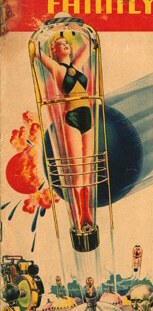
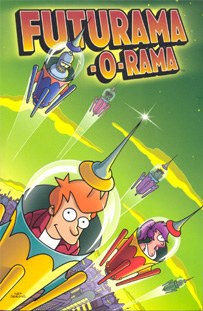
Back to Frank R. Paul Gallery Main Page
Back to Kitsch Tour U.S.A.
Back to Official Frank Wu Homepage